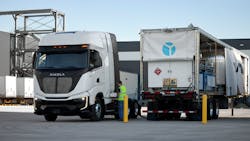Nikola commercial launch proves hydrogen trucks no longer a joke
Jason Roycht, global head of Fuel Cell Electric Vehicle Market Development for Nikola, gets the skepticism surrounding using hydrogen as a viable source to power the transportation industry.
“There’s a joke about fuel cells,” he quipped this summer. “Fuel cells are the powertrain of the future and they always will be.”
That future appears to be now, as Nikola commercially launched the Nikola Tre Fuel Cell Electric Vehicle on Sept. 28 at its Coolidge, Arizona production facility. Nikola was founded a little under a decade ago and has gone through enough scandals and adversity to last a century—but has won the race to get hydrogen-powered trucks to fleets in the U.S.
“It’s a testament to the relentless `can do’ attitude of our team and is a step closer to realizing our vision of sustainable and efficient transportation,” said Steve Girsky, Nikola president and CEO. “As we head into the fourth quarter, we are focused on delivering our trucks at scale and securing our position as pioneers in the hydrogen refueling ecosystem to support our customers.”
The Tre FCEV has an estimated range of 500 miles and 82,000-lb. GVWR. Fueling is expected to take less than 20 minutes, and while hydrogen stations are limited at best right now, Nikola’s energy business, HYLA, can deploy mobile fueling stations.
The Phoenix-based zero-emission truck maker started production on July 31 and has taken the last few months to validate the trucks are ready to be delivered to customers. Twenty-three fleet customers have placed a total of 223 non-binding orders for the FCEVs. These include J.B. Hunt, Biagi Bros. and TTSI.
With three shifts running, the Coolidge plant, which completed a Phase 2 assembly expansion, has the production capacity to churn out 2,400 trucks annually. The assembly line to produce the fuel cell power modules, which are supplied by Bosch, is slated to go online by the end of the year. Proterra supplies the batteries, which is an important note as the battery-electric version of the Tre, which use batteries designed by Romeo Power, have suffered a spate of battery fires. That required a recall of more than 200 BEVs.
Hydrogen, though, appears to be a strength for Nikola, with a strategy that incudes supplying hydrogen through its energy business, HYLA. The company also has service deals accords the country, such as with Alta Equipment Group. They will provide Nikola customers with installation, leasing, refueling and charging, and long-term maintenance in 15 states for both Tre models.
The Inflation Reduction Act has not done much for the American consumer, but its subsidies may ease the costs of hydrogen production. For the first decade of operation, a green (made via renewables) hydrogen producer may receive a $3-per-kg production tax credit. The IRA also provides fuel-cell customers with a $40,000 clean commercial vehicle tax credit. In California, the HVIP grant would provide an additional $288,000 per vehicle. The state’s Innovative Small e-Fleet program could also provide small fleets with up to $408,000 in incentives per vehicle.
The total cost on one Nikola FCEV has been estimated at more than $750,000.
Inflation Reduction Act, customers could be eligible for a $40,000 clean commercial vehicle tax credit, and the California HVIP grants up to $288,000 per FCEV.
“The driver is always TCO in the trucking industry,” said Thomas Wintrich, Bosch’s head of Fuel Cell Mobility Solutions, as the company rolled out its fuel-cell production in Stuttgart, Germany earlier in the month. “If you have the infrastructure and you can create TCO, which it seems Nikola can do for the trucks, then it becomes interesting.”
Competition heats up
Commercialization is only one of many battles. Nikola has a healthy head start now, but legacy OEMs are closing in. Daimler Truck and Volvo Trucks have made headways in the European market with testing on public roads. This week, Daimler reported its Mercedes-Benz GenH2 prototype exceeded 660 miles (1,0000+ km) with an 80,000-lb gross vehicle weight rating. (GVWR).
Paccar's Kenworth and Peterbilt brands will soon start taking orders for the hydrogen fuel-cell Class 8 tractor it developed with Toyota Motors.
Hyundai’s XCIENT (6x4) FCEV has deployed in five countries and is nearly ready to begin production in America. That fuel-cell tractor has a range of 450 miles and, as of last May, racked up 4 million miles of testing.
That’s just fuel cell competitors. Tesla, whose founder Elon Musk famously refers to fuel cells as “fool cells,” is grabbing attention for successful pilots of the Tesla Semi with Pepsi, During the North American Council for Freight Efficiency’s ongoing Run On Less- Electric Depot event, the Semi ran 1,600 miles in less than two days. This required five charging stops, and NACFE said the truck was “fairly fully loaded” throughout the run.
Over the decade, electric trucks, which have been in production for several years, are expected to improve in battery weight and efficiency and charging time—factors that for now put them behind FCEVs as potential options for longhaul trucking.
Roycht pointed out that EVs’ infrastructure hurdles are no laughing matter: “There are a number of our customers who for now can’t get access to the power requirements needed at their facilities at the time they need them to be able to charge more than a couple trucks.”
Those grid issues, along with the aforementioned EV questions, are all problems that a fuel cell hydrogen implementation can be a potential solution for.”
It’s still far too early to know how the hydrogen versus electric race will turn out, but one thing is for certain: hydrogen has proven it’s no joke anymore.
About the Author

John Hitch
Editor-in-chief, Fleet Maintenance
John Hitch is the award-winning editor-in-chief of Fleet Maintenance, where his mission is to provide maintenance leaders and technicians with the the latest information on tools, strategies, and best practices to keep their fleets' commercial vehicles moving.
He is based out of Cleveland, Ohio, and has worked in the B2B journalism space for more than a decade. Hitch was previously senior editor for FleetOwner and before that was technology editor for IndustryWeek and and managing editor of New Equipment Digest.
Hitch graduated from Kent State University and was editor of the student magazine The Burr in 2009.
The former sonar technician served honorably aboard the fast-attack submarine USS Oklahoma City (SSN-723), where he participated in counter-drug ops, an under-ice expedition, and other missions he's not allowed to talk about for several more decades.
